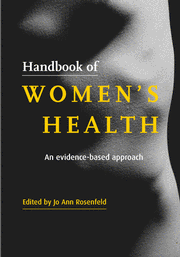Book contents
- Frontmatter
- Contents
- List of contributors
- Common abbreviations used in the text
- Normal blood values in women and during pregnancy
- Introduction
- 1 Singular health care of women
- Preventive care
- Psychosocial health
- Sexuality
- 9 Sexuality and sexual dysfunction through the life cycle
- 10 Contraception
- 11 Infertility and adoption
- 12 Special issues with lesbian patients
- 13 Medical care in pregnancy: common preconception and antepartum issues
- Genitourinary medicine
- Breast disorders
- Psychological disorders
- Common medical problems
- Index
9 - Sexuality and sexual dysfunction through the life cycle
Published online by Cambridge University Press: 28 October 2009
- Frontmatter
- Contents
- List of contributors
- Common abbreviations used in the text
- Normal blood values in women and during pregnancy
- Introduction
- 1 Singular health care of women
- Preventive care
- Psychosocial health
- Sexuality
- 9 Sexuality and sexual dysfunction through the life cycle
- 10 Contraception
- 11 Infertility and adoption
- 12 Special issues with lesbian patients
- 13 Medical care in pregnancy: common preconception and antepartum issues
- Genitourinary medicine
- Breast disorders
- Psychological disorders
- Common medical problems
- Index
Summary
Sexuality is a significant aspect of all individuals' lives. Physicians and health care professionals, who provide longitudinal care to individuals and families, have both an opportunity and a responsibility to provide appropriate counselling, anticipatory guidance and education for their patients regarding sexual concerns occurring throughout the life cycle.
Introduction
Sexual issues are frequently ignored in practice, for a variety of reasons. Physicians must be aware that sexual behavior, in addition to procreation, serves many other functions related to physiological and psychological development. Sexuality provides individuals with a way to express their feelings, demonstrate caring, and communicate and develop intimacy with another person. As such, sexual expression becomes a source of pleasure and fulfillment. For couples, it is a powerful form of communication.
Medical concerns
Physicians have the responsibility to address the sexual concerns of their patients. Many women regard their physicians as experts in the area of human sexuality. There are many medical and developmental concerns that will impact on sexual behavior, and questions may concern psychosexual development, contraception, STD counselling and the impact of various illnesses, such as depression, substance abuse, physical disability, and diabetes, on sexuality. These provide a springboard for physician inquiry into the sexual health of their patients. Many illnesses impact on sexual behavior and if not discussed, will be ignored.
Physician reluctance
While most practitioners have had some training in taking sexual histories during medical school, many physicians are reluctant to pursue this issue with their patients.
- Type
- Chapter
- Information
- Handbook of Women's HealthAn Evidence-Based Approach, pp. 131 - 152Publisher: Cambridge University PressPrint publication year: 2001



